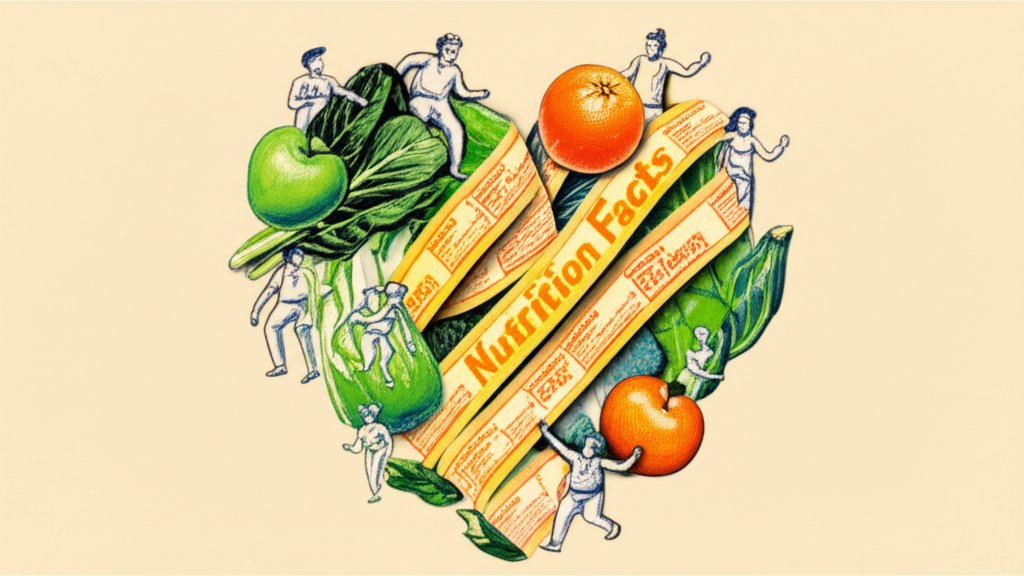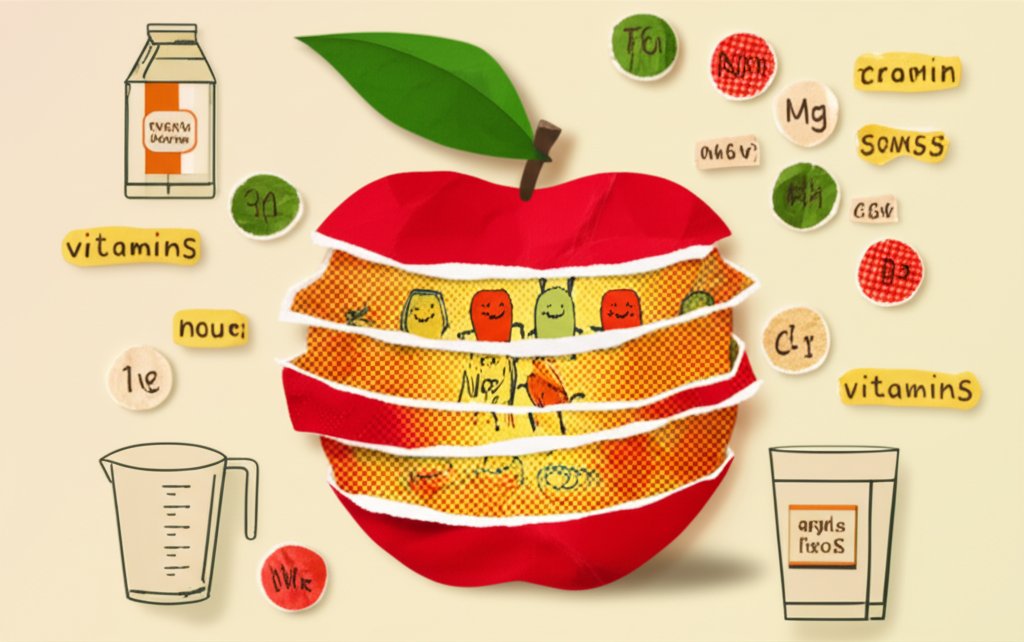Ever wonder exactly what you’re getting when you reach for that glass of apple juice? It’s more than just a sweet treat; understanding the nutrition facts in apple juice can help you make informed choices about your diet. This guide breaks down everything you need to know, from calories and sugars to vitamins and minerals, so you can enjoy apple juice with confidence.
At a Glance:
- A one-cup serving of apple juice contains around 110-120 calories.
- It’s a good source of carbohydrates and sugars, providing quick energy.
- Apple juice contains some essential vitamins and minerals, like potassium and vitamin C.
- Be mindful of the sugar content, especially if you’re watching your intake.
- Consider the type of apple juice (e.g., single-strength, concentrated) for varying nutritional profiles.
A Sip Through History: The Story of Apple Juice
Apple juice boasts a surprisingly long history. Believe it or not, evidence suggests that ancient Egyptians enjoyed apple juice as far back as 2400 BCE! Fast forward to medieval Europe, and farmers were crafting cider and other apple-based beverages. In the American colonies, apple cider was a popular drink by the 1500s. While alcoholic versions were common, non-alcoholic apple juice was also enjoyed. Mass production of canned and bottled apple juice really took off in the 1940s, making it the readily available drink we know today.
What’s in That Glass? A Deep Dive into Apple Juice Nutrition
Let’s get down to the nitty-gritty. A typical one-cup (8-ounce or 240ml) serving of apple juice contains:
- Calories: 114-117
- Total Fat: 0.3g (0% Daily Value)
- Saturated Fat: 0.1g (0% Daily Value)
- Polyunsaturated Fat: 0.1g
- Monounsaturated Fat: 0g
- Cholesterol: 0mg (0% Daily Value)
- Sodium: 7-10mg (0% Daily Value)
- Total Carbohydrates: 28-29g (10-11% Daily Value)
- Dietary Fiber: 0.2-0.5g (1-2% Daily Value)
- Sugars: 24-27g
- Protein: 0.15-0.3g
- Vitamin D: 0mcg (0% Daily Value)
- Calcium: 17-20mg (1-2% Daily Value)
- Iron: 0.3-0.9mg (2-5% Daily Value)
- Potassium: 250-295mg (5-6% Daily Value)
- Vitamin C: 27.5mg (31% Daily Value) – Note: This can vary significantly based on whether the juice has added ascorbic acid (Vitamin C).
Keep in mind that these values can vary slightly depending on the brand and processing methods.
Breaking Down the Macros: Carbs, Fats, and Protein
Apple juice is primarily a carbohydrate source. Let’s examine each macronutrient:
- Carbohydrates: The dominant macronutrient in apple juice, providing quick energy in the form of sugars.
- Fats: Apple juice is very low in fat, with only trace amounts present. These are mostly polyunsaturated fats.
- Protein: Similar to fats, apple juice contains minimal protein.
Vitamins and Minerals: What You’re Really Getting
While not a nutritional powerhouse, apple juice does contain some beneficial vitamins and minerals:
- Potassium: Important for maintaining healthy blood pressure and fluid balance.
- Vitamin C: An antioxidant that supports the immune system, although the amount can vary. Some manufacturers add ascorbic acid to boost the Vitamin C content.
- Iron: Essential for carrying oxygen in the blood.
- Calcium: Important for bone health.
The Sugar Question: Understanding the Impact

The high sugar content in apple juice is a significant factor to consider. Most of the carbohydrates in apple juice come from naturally occurring sugars like fructose and glucose. While these are natural, they can still impact blood sugar levels, especially if you consume large quantities. If you are watching your sugar intake, consider diluting apple juice with water or opting for smaller servings. You might be surprised what Laffy Taffy Nutrition Information reveals about another popular treat!
Apple Juice vs. Whole Apples: A Key Difference
It’s crucial to understand that apple juice doesn’t offer the same nutritional benefits as eating a whole apple. Whole apples contain significant amounts of fiber, which helps regulate blood sugar, promote digestive health, and contribute to feelings of fullness. Apple juice, on the other hand, typically contains very little fiber because it’s removed during processing. This is why eating an apple is generally considered a healthier choice compared to drinking apple juice.
Processing Matters: How Apple Juice is Made and Why It Affects Nutrition
The way apple juice is processed significantly impacts its nutritional profile. Here’s a glimpse into the journey from orchard to your glass:
- Harvesting and Pressing: Freshly harvested apples are pressed and blended to create juice.
- Pasteurization: The juice is heated to kill harmful pathogens while preserving flavor and nutrition, using a process called flash-pasteurization.
- Filtration: Solids like skin and pulp are removed, resulting in a clearer juice.
- Packaging: The juice is bottled or canned and sealed.
- Centrifugation: Some manufacturers use centrifugation after pasteurization, separating solids and further clarifying the juice.
Different processing methods can affect the final product’s clarity, flavor, and nutritional content.
Types of Apple Juice: Single-Strength, Concentrated, and Frozen
Apple juice comes in various forms:
- Single-Strength Juice: This is juice that hasn’t been concentrated.
- Double-Strength Juice: This juice has been concentrated and then rehydrated. It’s often more expensive due to the higher apple usage.
- Frozen Apple Juice Concentrate: The juice is concentrated and frozen, requiring you to add water before consumption. It is generally cheaper due to efficiency in storage and transportation.
Choose the type that best suits your needs and budget.
Decoding the Label: What to Look For
When buying apple juice, pay attention to the nutrition label. Look for:
- Serving Size: This determines the amount of nutrients you’re getting per serving.
- Sugar Content: Be mindful of the total sugars listed.
- Added Nutrients: Check if the juice has been fortified with vitamins or minerals.
- Ingredients: Opt for juice with minimal added ingredients.
Apple Juice and Health: Potential Benefits and Considerations
Apple juice can offer some health benefits:
- Hydration: It’s a good source of fluids, helping you stay hydrated.
- Energy Boost: The sugars provide a quick source of energy.
- Antioxidants: Apple juice contains natural antioxidants that may protect against cell damage. Studies suggest that drinking at least one cup of juice per day may decrease the risk of stroke, hypertension, heart attack, and diabetes..
However, there are also considerations: - Blood Sugar Spikes: The high sugar content can lead to rapid increases in blood sugar levels.
- Weight Gain: Excessive consumption can contribute to weight gain due to the caloric content.
- Dental Health: The sugars can contribute to tooth decay.
Common Questions About Apple Juice

Let’s address some frequently asked questions:
- Is apple juice good for you? In moderation, it can be a source of hydration and some nutrients. However, whole apples are a healthier choice due to their fiber content.
- Is apple juice okay for diabetics? Individuals with diabetes should be cautious due to the sugar content. Diluted juice or small servings may be preferable.
- Does apple juice help with constipation? Apple juice can have a mild laxative effect due to its sugar content.
- Is apple juice good for a cold? The Vitamin C in apple juice can help support the immune system, potentially easing cold symptoms.
Burning Those Calories: How Much Exercise Does It Take?
Want to know how long it takes to burn off the calories in a cup of apple juice? Here’s a rough estimate (based on a 140-pound person):
- Walking (3 mph): 31 minutes
- Running (6 mph): 11 minutes
- Bicycling (10 mph): 16 minutes
Making Informed Choices: Tips for Enjoying Apple Juice Responsibly
Here are some practical tips for including apple juice in your diet without overdoing it:
- Limit Portion Sizes: Stick to one-cup servings.
- Dilute with Water: Cut down on sugar by mixing apple juice with water.
- Choose 100% Juice: Avoid juices with added sugars or artificial sweeteners.
- Pair with Protein or Fiber: Consuming apple juice with a source of protein or fiber can help stabilize blood sugar levels.
- Consider Unsweetened Varieties: If available, opt for unsweetened apple juice.
Beyond the Glass: Creative Uses for Apple Juice
Apple juice isn’t just for drinking! Get creative with these uses:
- Marinades: Use apple juice as a base for marinades for chicken or pork.
- Smoothies: Add apple juice to smoothies for a touch of sweetness.
- Baking: Incorporate apple juice into baked goods like cakes and muffins.
From Orchard to Store: The Journey of Your Apple Juice
Ever wonder how apple juice makes its way from the orchard to your table? Here’s a simplified overview:
- Apple Growing: Farmers select apple varieties suitable for juice production and manage their orchards with pruning, fertilization, and pest control.
- Harvesting: Apples are picked and transported to processing facilities.
- Sorting and Washing: Apples are sorted, graded, and washed to remove dirt and residue.
- Crushing: Apples are crushed into small pieces to facilitate juice extraction.
- Juice Extraction: The apple pieces are pressed to extract the juice.
- Pasteurization: The juice is pasteurized to kill harmful bacteria.
- Packaging: The juice is packaged into cans, bottles, or aseptic containers.
- Transportation: The juice is transported to stores and restaurants, often using refrigerated trucks. The whole process is complex, and it’s worth taking a moment to consider the nutritional implications of choices we make daily. For example, those interested in Uncover Doritos Nutritional Information should consider these facts in light of their regular diet and choices.
- Serving: The juice is served chilled or at room temperature, ready for you to enjoy.
Your Next Step: Making Informed Choices
Understanding the nutrition facts in apple juice empowers you to make informed decisions about your diet. While it can be a refreshing and convenient beverage, it’s important to be mindful of its sugar content and consider it as part of a balanced diet. Remember that whole apples offer more nutritional benefits due to their fiber content. Enjoy apple juice in moderation, and prioritize whole fruits for optimal health.
- How Glass Bento Box Containers Make Meal Prep Easier - December 18, 2025
- Why Glass Boxes for Lunch Are Trending for Meal Prep - December 17, 2025
- Bento Box Glass Offers Practical, Eco-Friendly Meal Storage - December 16, 2025










